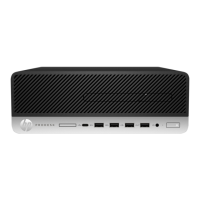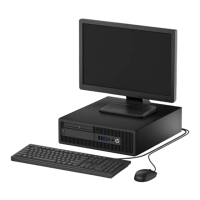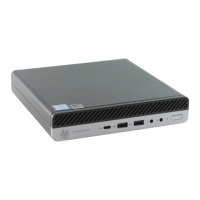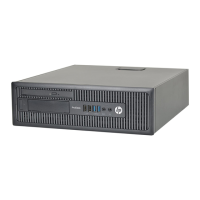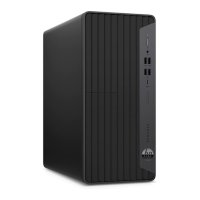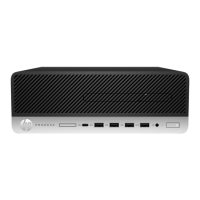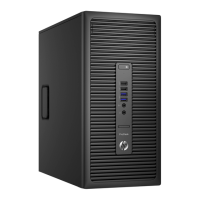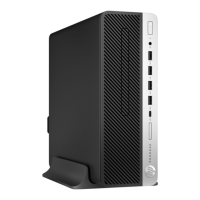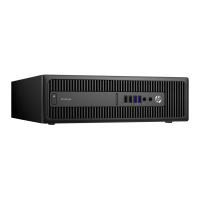Do you have a question about the HP ProDesk 600 G5 and is the answer not in the manual?
Lists standard hardware and software features of the computer.
Identifies and describes components on the front of the computer.
Identifies and describes components on the rear of the computer.
Explains where to find the unique serial and product ID numbers.
Lists and illustrates the main internal and external components of the computer.
Lists various miscellaneous parts that are not considered major components.
Explains electrostatic discharge and how to prevent damage to components.
Details equipment and methods for personal grounding to prevent ESD.
Provides precautions for grounding the work area to prevent static damage.
Lists recommended materials and equipment for preventing static electricity.
Provides guidelines for operating the computer to prevent overheating and prolong life.
Covers general cleaning safety precautions and procedures for computer components.
Lists considerations for disassembly and assembly of the computer.
Lists the necessary tools and software for servicing the computer.
Discusses the importance of using correct screws during reassembly.
Discusses handling and care of hard drives as delicate components.
Explains the function and warnings for the lithium coin cell battery.
Provides technical characteristics for SATA hard drives.
Provides critical warnings and cautions before performing any removal or replacement.
Outlines the necessary steps to prepare the computer for disassembly.
Instructions for cleaning and replacing the front bezel dust filter.
Procedure for removing the computer's access panel.
Procedure for removing and replacing the front bezel of the computer.
Procedure for removing and replacing the hood sensor.
Procedure for removing and replacing the computer's speaker.
Procedure for removing and replacing the computer's hard drive.
Procedure for removing and replacing the hard drive connector.
Procedure for removing and replacing the computer's drive cage.
Procedure for removing and replacing the M.2 PCIe solid state drive (SSD).
Procedure for removing and replacing the WLAN module.
Procedure for replacing the computer's lithium coin cell battery.
Procedure for removing and replacing the expansion connector board.
Details specifications and procedures for removing and installing memory modules.
Procedure for removing and replacing the computer's fan.
Procedure for removing and replacing the heat sink, including thermal grease.
Procedure for removing and replacing the computer's processor.
Procedure for removing and replacing the system board, including thermal pads.
Details how to update System Management BIOS (SMBIOS) information after replacing the system board.
Identifies and labels the components on the computer's system board.
Procedure for routing and replacing internal WLAN antenna cables.
Instructions for converting the computer from a desktop to a tower orientation.
Explains the various functions and purposes of the Computer Setup utility.
Step-by-step instructions on how to access and navigate the Computer Setup utility.
Details the options available in the Main section of the Computer Setup utility.
Details the security-related options within the Computer Setup utility.
Details advanced configuration options for the Computer Setup utility.
Information on accessing the 3rd Party Option ROM Management application.
Instructions for backing up and restoring computer configuration settings.
Addresses safety and comfort considerations for using the computer.
Lists preliminary troubleshooting steps to perform before contacting support.
Offers general suggestions for resolving computer, monitor, or software issues.
Provides solutions for common general computer problems.
Offers solutions for various power-related issues the computer may experience.
Provides solutions for common hard drive errors and performance issues.
Offers solutions for problems encountered with media card readers.
Provides solutions for common display issues and monitor problems.
Offers solutions for common audio issues, including sound cuts and no sound.
Provides solutions for common printer issues, such as not printing or garbled output.
Offers solutions for common keyboard and mouse operational problems.
Provides solutions for issues related to installing new hardware components.
Offers solutions for common network connectivity and driver issues.
Provides solutions for common memory-related errors and performance issues.
Offers solutions for problems encountered with USB flash drives.
Provides solutions for issues related to connecting to the Internet.
Offers solutions for common software-related problems.
Covers POST errors with numeric codes and associated text messages.
Explains how to interpret diagnostic front panel LEDs and audible codes for system validation.
Procedure for resetting passwords by using the password jumper.
Steps to reset BIOS settings to factory defaults using the CMOS button.
Instructions for using the HP PC Hardware Diagnostics utility within Windows.
Steps to download the HP PC Hardware Diagnostics Windows tool.
Instructions for installing the HP PC Hardware Diagnostics Windows tool.
Instructions for using the HP PC Hardware Diagnostics UEFI tool outside the OS.
Steps to download the latest version of HP PC Hardware Diagnostics UEFI.
Steps to download the UEFI tool using product name or number.
How to use and customize remote diagnostic settings.
Steps to download remote diagnostic software.
Steps to download the latest remote diagnostic version.
Steps to download remote diagnostic software by product name or number.
How to customize remote diagnostic settings via Computer Setup.
Lists general power cord requirements applicable to all countries.
Specifies power cord requirements for use in Japan.
Lists specific power cord requirements and accrediting agencies for various countries.
Provides BIOS steps to restore nonvolatile memory and clear personal data.
Details usage, data retention, purpose, and write protection for various nonvolatile memory types.
Steps to restore BIOS settings to their factory defaults.
Explains UEFI BIOS and its differences from legacy BIOS.
Identifies the physical location of the UEFI BIOS on the system.
Describes SPD data and how it is written to memory modules.
Clarifies the meaning of restoring nonvolatile memory on Intel-based systems.
Steps to reset BIOS security to defaults and securely erase data.
Procedure for resetting Custom Secure Boot Keys.
Guide to using HP Sure Start, a BIOS monitoring and recovery technology.
Lists standard hardware and software features of the computer.
Identifies and describes components on the front of the computer.
Identifies and describes components on the rear of the computer.
Explains where to find the unique serial and product ID numbers.
Lists and illustrates the main internal and external components of the computer.
Lists various miscellaneous parts that are not considered major components.
Explains electrostatic discharge and how to prevent damage to components.
Details equipment and methods for personal grounding to prevent ESD.
Provides precautions for grounding the work area to prevent static damage.
Lists recommended materials and equipment for preventing static electricity.
Provides guidelines for operating the computer to prevent overheating and prolong life.
Covers general cleaning safety precautions and procedures for computer components.
Lists considerations for disassembly and assembly of the computer.
Lists the necessary tools and software for servicing the computer.
Discusses the importance of using correct screws during reassembly.
Discusses handling and care of hard drives as delicate components.
Explains the function and warnings for the lithium coin cell battery.
Provides technical characteristics for SATA hard drives.
Provides critical warnings and cautions before performing any removal or replacement.
Outlines the necessary steps to prepare the computer for disassembly.
Instructions for cleaning and replacing the front bezel dust filter.
Procedure for removing the computer's access panel.
Procedure for removing and replacing the front bezel of the computer.
Procedure for removing and replacing the hood sensor.
Procedure for removing and replacing the computer's speaker.
Procedure for removing and replacing the computer's hard drive.
Procedure for removing and replacing the hard drive connector.
Procedure for removing and replacing the computer's drive cage.
Procedure for removing and replacing the M.2 PCIe solid state drive (SSD).
Procedure for removing and replacing the WLAN module.
Procedure for replacing the computer's lithium coin cell battery.
Procedure for removing and replacing the expansion connector board.
Details specifications and procedures for removing and installing memory modules.
Procedure for removing and replacing the computer's fan.
Procedure for removing and replacing the heat sink, including thermal grease.
Procedure for removing and replacing the computer's processor.
Procedure for removing and replacing the system board, including thermal pads.
Details how to update System Management BIOS (SMBIOS) information after replacing the system board.
Identifies and labels the components on the computer's system board.
Procedure for routing and replacing internal WLAN antenna cables.
Instructions for converting the computer from a desktop to a tower orientation.
Explains the various functions and purposes of the Computer Setup utility.
Step-by-step instructions on how to access and navigate the Computer Setup utility.
Details the options available in the Main section of the Computer Setup utility.
Details the security-related options within the Computer Setup utility.
Details advanced configuration options for the Computer Setup utility.
Information on accessing the 3rd Party Option ROM Management application.
Instructions for backing up and restoring computer configuration settings.
Addresses safety and comfort considerations for using the computer.
Lists preliminary troubleshooting steps to perform before contacting support.
Offers general suggestions for resolving computer, monitor, or software issues.
Provides solutions for common general computer problems.
Offers solutions for various power-related issues the computer may experience.
Provides solutions for common hard drive errors and performance issues.
Offers solutions for problems encountered with media card readers.
Provides solutions for common display issues and monitor problems.
Offers solutions for common audio issues, including sound cuts and no sound.
Provides solutions for common printer issues, such as not printing or garbled output.
Offers solutions for common keyboard and mouse operational problems.
Provides solutions for issues related to installing new hardware components.
Offers solutions for common network connectivity and driver issues.
Provides solutions for common memory-related errors and performance issues.
Offers solutions for problems encountered with USB flash drives.
Provides solutions for issues related to connecting to the Internet.
Offers solutions for common software-related problems.
Covers POST errors with numeric codes and associated text messages.
Explains how to interpret diagnostic front panel LEDs and audible codes for system validation.
Procedure for resetting passwords by using the password jumper.
Steps to reset BIOS settings to factory defaults using the CMOS button.
Instructions for using the HP PC Hardware Diagnostics utility within Windows.
Steps to download the HP PC Hardware Diagnostics Windows tool.
Instructions for installing the HP PC Hardware Diagnostics Windows tool.
Instructions for using the HP PC Hardware Diagnostics UEFI tool outside the OS.
Steps to download the latest version of HP PC Hardware Diagnostics UEFI.
Steps to download the UEFI tool using product name or number.
How to use and customize remote diagnostic settings.
Steps to download remote diagnostic software.
Steps to download the latest remote diagnostic version.
Steps to download remote diagnostic software by product name or number.
How to customize remote diagnostic settings via Computer Setup.
Lists general power cord requirements applicable to all countries.
Specifies power cord requirements for use in Japan.
Lists specific power cord requirements and accrediting agencies for various countries.
Provides BIOS steps to restore nonvolatile memory and clear personal data.
Details usage, data retention, purpose, and write protection for various nonvolatile memory types.
Steps to restore BIOS settings to their factory defaults.
Explains UEFI BIOS and its differences from legacy BIOS.
Identifies the physical location of the UEFI BIOS on the system.
Describes SPD data and how it is written to memory modules.
Clarifies the meaning of restoring nonvolatile memory on Intel-based systems.
Steps to reset BIOS security to defaults and securely erase data.
Procedure for resetting Custom Secure Boot Keys.
Guide to using HP Sure Start, a BIOS monitoring and recovery technology.
| Chipset | Intel Q370 |
|---|---|
| RAM | Up to 64 GB DDR4-2666 SDRAM |
| Storage | HDD, SSD, NVMe SSD options |
| Graphics | Intel UHD Graphics, optional discrete graphics |
| Operating System | Windows 10 Pro |
| Form Factor | Small Form Factor |
| USB Ports | Multiple USB 3.1 Gen 1 and Gen 2 ports |
| Network | Gigabit Ethernet, optional Wi-Fi |
| Ports (Front) | USB, audio |
| Ports (Rear) | USB, HDMI, DisplayPort, VGA, audio, Ethernet |
| Expansion Slots | PCIe x16, PCIe x1, M.2 |
| Ports | Varies by form factor |
| Security | TPM 2.0, Kensington lock slot, chassis intrusion switch |
| Processor | Intel Core i3/i5/i7/i9, Pentium, Celeron (processor options vary by region) |
